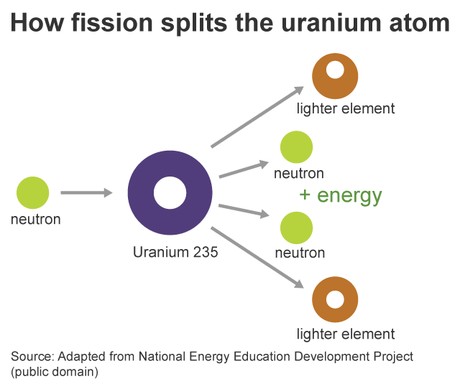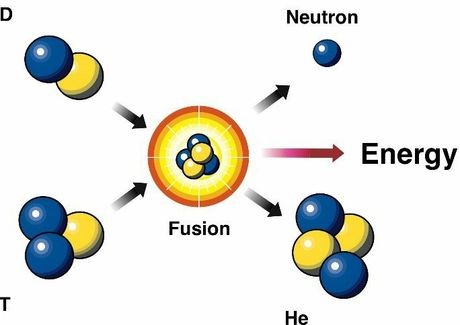Harnessing energy from the atom’s nucleus is the foundation of nuclear power, achieved through two distinct processes: nuclear fission and nuclear fusion. Both methods alter atoms to release tremendous energy, but they operate on fundamentally different principles. Understanding the nuances between these processes is crucial for grasping the past, present, and future of energy production.
Nuclear Fission: Splitting the Atom
Nuclear fission is the process of splitting a heavy, unstable atomic nucleus into two or more lighter nuclei. This is typically initiated by bombarding the nucleus with neutrons. Imagine splitting a log of wood with an axe; in nuclear fission, a neutron acts as the axe, and the heavy nucleus, such as Uranium-235, is the log.
When a neutron strikes a fissile material like Uranium-235, the nucleus becomes unstable and splits. This split releases a significant amount of energy in the form of heat and radiation, along with additional neutrons. These newly released neutrons can then trigger further fission reactions in nearby Uranium-235 nuclei, creating a chain reaction. This chain reaction, if controlled, is the basis for nuclear power plants.
Diagram illustrating nuclear fission, where a neutron splits a uranium nucleus into smaller particles and releases energy.
In nuclear reactors, this controlled chain reaction heats water, producing steam that drives turbines to generate electricity. Fission is a well-established technology, currently utilized in nuclear power plants worldwide to provide a substantial portion of global electricity.
Nuclear Fusion: Joining Atoms Together
In contrast to fission, nuclear fusion is the process of combining two light atomic nuclei to form a heavier nucleus. This process occurs under extreme conditions of temperature and pressure, similar to those found in the core of the sun. Think of it like merging two small water droplets to form a larger one, but at an atomic level and with immense energy release.
Fusion typically involves isotopes of hydrogen, such as deuterium (Hydrogen-2) and tritium (Hydrogen-3). Under immense pressure and temperatures millions of degrees Celsius, these isotopes overcome their natural repulsion and fuse together, forming a helium nucleus and releasing a neutron, along with a tremendous amount of energy. This energy release is even greater than that from fission reactions.
Illustration of nuclear fusion, depicting two hydrogen isotopes combining to form helium, releasing energy and a neutron.
The sun and other stars are powered by nuclear fusion. The intense gravitational pressure in their cores creates the necessary conditions for hydrogen nuclei to fuse, producing the light and heat that sustains life on Earth. Scientists are striving to replicate these conditions on Earth to harness fusion energy for power generation.
Fission vs. Fusion: Key Differences and Similarities
While both fission and fusion are nuclear processes that release energy, they differ significantly in their mechanisms, fuel, byproducts, and stage of technological development. Here’s a comparison:
| Feature | Nuclear Fission | Nuclear Fusion |
|---|---|---|
| Process | Splitting of heavy nuclei | Combining of light nuclei |
| Fuel | Heavy elements (e.g., Uranium-235) | Light elements (e.g., Hydrogen isotopes) |
| Energy Output | High energy release | Even higher energy release than fission |
| Byproducts | Radioactive waste products | Relatively less radioactive waste (primarily neutrons) |
| Conditions | Achieved under controlled conditions in reactors | Requires extremely high temperature and pressure |
| Control | Controllable chain reaction | Difficult to control and sustain reaction |
| Applications | Nuclear power plants, atomic weapons | Potential for power generation, experimental reactors |
| Development | Established technology | Still in experimental and developmental stages |


Similarities:
- Both are nuclear reactions converting mass into energy (following Einstein’s E=mc²).
- Both release vast amounts of energy compared to chemical reactions.
- Both have the potential to be used for large-scale energy production.
Conclusion: The Future of Nuclear Energy
Nuclear fission and fusion represent two powerful pathways to unlock energy from the atom. Fission is a mature technology providing substantial power today, but it comes with challenges related to radioactive waste and the risk of accidents. Fusion, while still in its infancy, promises a cleaner and more sustainable energy source with abundant fuel. Ongoing research and development in fusion energy hold the potential to revolutionize energy production in the future, mirroring the energy source that powers the sun itself. Understanding both fission and fusion is crucial for navigating the complex landscape of nuclear energy and its role in meeting global energy demands.
